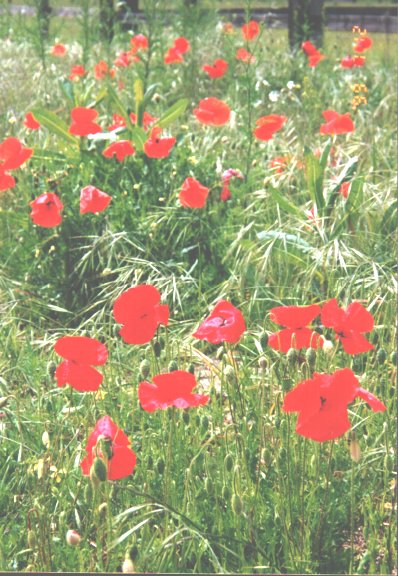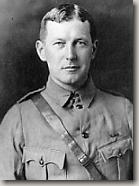|
|
|
In Flanders Fields
by John McCrae
In Flanders fields the poppies blow
Between the crosses, row on row,
That mark our place; and in the sky
The larks, still bravely singing, fly
Scarce heard amid the guns below.
We are the Dead. Short days ago
We lived, felt dawn, saw sunset glow,
Loved, and were loved, and now we lie
In Flanders fields.
Take up our quarrel with the foe:
To you from failing hands we throw
The torch; be yours to hold it high.
If ye break faith with us who die
We shall not sleep, though poppies grow
In Flanders fields.
|
| |
Why the Red Poppy?
At war memorials all over Britain, and on the Continent as well, one will find wreaths of red poppy. The Red Remembrance Poppy takes its roots from the poppy fields of Flanders, where so many soldiers lost their lives in World War I.
The Fields of Flanders were rendered immortal by the poem by John McCrae. "In Flanders Fields" remains to this day one of the most memorable war poems ever written. It is a lasting legacy of the terrible battle in the Ypres salient in the spring of 1915.
|
 A Poppy Field
A Poppy Field |
| |
One of the most asked questions is: why poppies? The answer is simple: poppies only flower in rooted up soil. Their seeds can lie on the ground for years on end, and only when someone roots up the ground, they will sprout. There was enough rooted up soil on the battlefield of the Western Front; in fact the whole front consisted of churned up soil. So in May 1915, when McCrae wrote his poem, around him poppies blossomed like no one had ever seen before.
|
 In Remberance
In Remberance |
| |
Poppies: Lasting Emblem to Fallen Soldiers
For those who know the poem, "In Flanders Fields" written by John McCrae, a doctor in the First Canadian Brigade during the Second Battle of Ypres, the poppy stands out as the symbol of those who were killed or disabled by war.
McCrae had written and published several poems, before "In Flanders Fields". He is said to have written this, his most famous work just twenty minutes after performing the funeral service for a friend killed by shellfire.
The cause of McCrae's friend's violent end was the Second Battle of Ypres, 1915, a battle in which the Germans unleashed 5,700 cylinders of chlorine gas with devastating effect. It was the first time the new and horrible weapon had been used, leading to the dramatic result of an entire unit of French colonial troops, seen fleeing to the rear, leaving their gasping and dying comrades in the front-line trenches.
A large gap opened up in the Allied lines, an opening the Germans were slow to exploit.
McCrae had set up a field hospital and helped bury the men he couldn't save. Soon after the fields were dotted with row after row of simple white crosses, corn poppies, or P. rhoeas sprang up over the graves. The ancient flower species, native to Europe, had dormant seeds exposed to sunlight by the battle's churning of the topsoil.
McCrae's poem was first published in Punch on December 8, 1915. The poet/soldier did not live to see the end of the conflict. McCrae died of pneumonia in 1918, just 10 months before the Armistice. His poem lived on.
|
 John McCrae (1872-1918)
John McCrae (1872-1918) |
|
|


